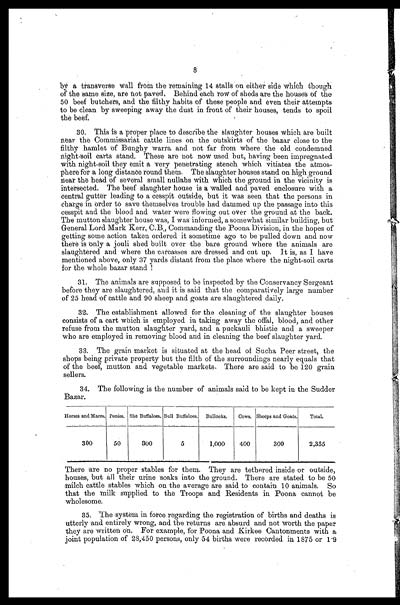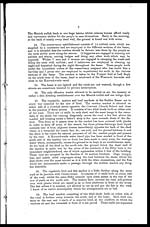Medicine - Institutions > Army health reports and medical documents > Reports on military cantonments and civil stations in the Presidency of Bombay inspected by the Sanitary Commissioner in the years 1875 and 1876 > Part I [i.e. 1] - Reports on military cantonments inspected in 1876
(141) Page 8
Download files
Individual page:
Thumbnail gallery: Grid view | List view

8
by a transverse wall from the remaining 14 stalls on either side which though
of the same size, are not paved. Behind each row of sheds are the houses of the
50 beef butchers, and the filthy habits of these people and even their attempts
to be clean by sweeping away the dust in front of their houses, tends to spoil
the beef.
30. This is a proper place to describe the slaughter houses which are built
near the Commissariat cattle lines on the outskirts of the bazar close to the
filthy hamlet of Bunghy warra and not far from where the old condemned
night-soil carts stand. These are not now used but, having been impregnated
with night-soil they emit a very penetrating stench which vitiates the atmos-
phere for a long distance round them. The slaughter houses stand on high ground
near the head of several small nullahs with which the ground in the vicinity is
intersected. The beef slaughter house is a walled and paved enclosure with a
central gutter leading to a cesspit outside, but it was seen that the persons in
charge in order to save themselves trouble had dammed up the passage into this
cesspit and the blood and water were flowing out over the ground at the back.
The mutton slaughter house was, I was informed, a somewhat similar building, but
General Lord Mark Kerr, C.B., Commanding the Poona Division, in the hopes of
getting some action taken ordered it sometime ago to be pulled down and now
there is only a jouli shed built over the bare ground where the animals are
slaughtered and where the carcasses are dressed and cut up. It is, as I have
mentioned above, only 37 yards distant from the place where the night-soil carts
for the whole bazar stand !
31. The animals are supposed to be inspected by the Conservancy Sergeant
before they are slaughtered, and it is said that the comparatively large number
of 25 head of cattle and 90 sheep and goats are slaughtered daily.
32. The establishment allowed for the cleaning of the slaughter houses
consists of a cart which is employed in taking away the offal, blood, and other
refuse from the mutton slaughter yard, and a puckauli bhistie and a sweeper
who are employed in removing blood and in cleaning the beef slaughter yard.
33. The grain market is situated at the head of Sucha Peer street, the
shops being private property but the filth of the surroundings nearly equals that
of the beef, mutton and vegetable markets. There are said to be 120 grain
sellers.
34. The following is the number of animals said to be kept in the Sudder
Bazar.
| Horses and Mares. | Ponies. | She Buffaloes. | Bull Buffaloes. | Bullocks. | Cows. | Sheeps and Goats. | Total. |
| 300 | 50 | 300 | 5 | 1,000 | 400 | 300 | 2,355 |
There are no proper stables for them. They are tethered inside or outside,
houses, but all their urine soaks into the ground. There are stated to be 50
milch cattle stables which on the average are said to contain 10 animals. So
that the milk supplied to the Troops and Residents in Poona cannot be
wholesome.
35. The system in force regarding the registration of births and deaths is
utterly and entirely wrong, and the returns are absurd and not worth the paper
they are written on. For example, for Poona and Kirkee Cantonments with a
joint population of 28,450 persons, only 54 births were recorded in 1875 or 1.9
Set display mode to: Large image | Zoom image | Transcription
Images and transcriptions on this page, including medium image downloads, may be used under the Creative Commons Attribution 4.0 International Licence unless otherwise stated. ![]()
| Permanent URL | https://digital.nls.uk/75008946 |
|---|




